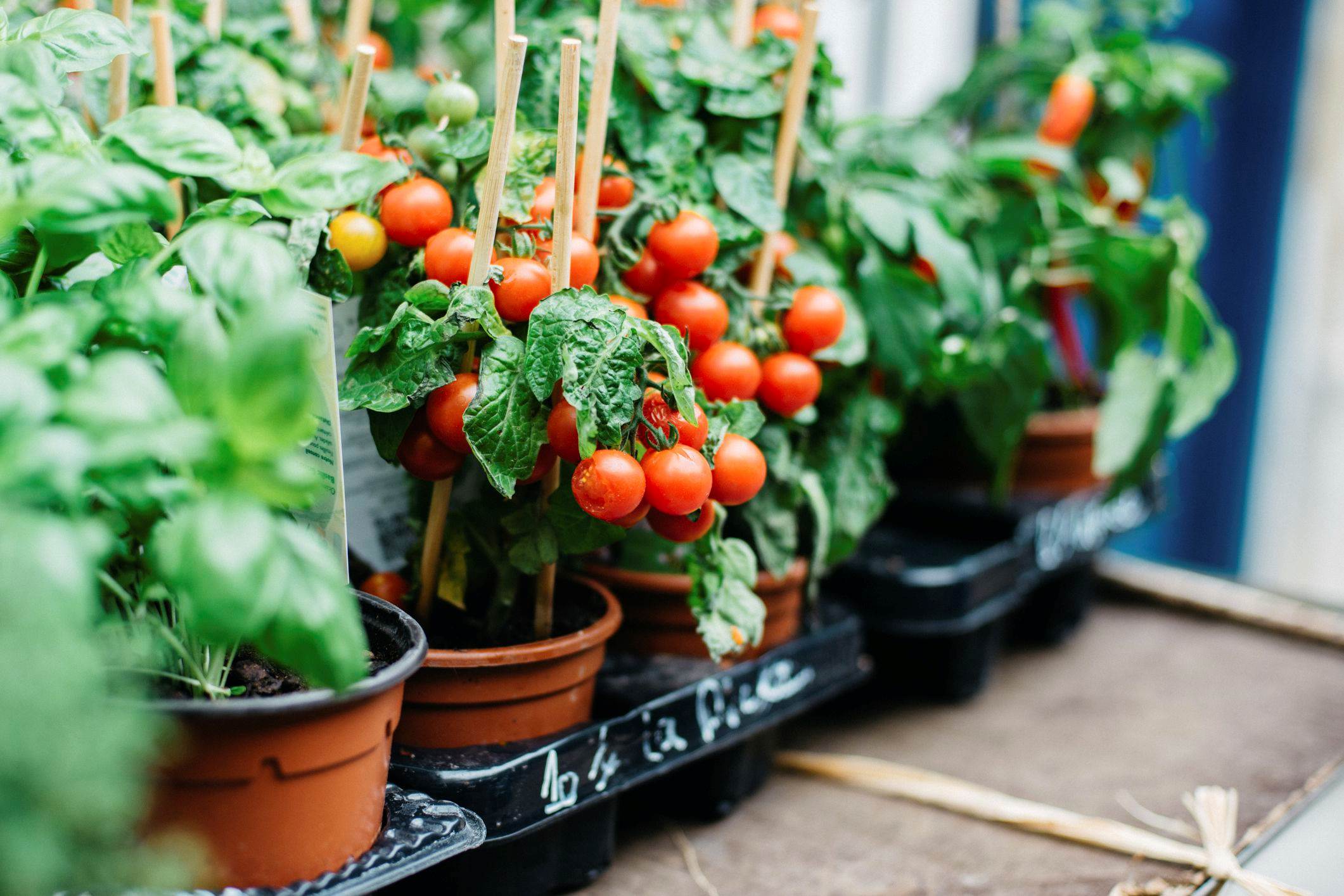Home>Types of Gardening>Edible Gardening>What Are The Types Of Vegetables


Edible Gardening
What Are The Types Of Vegetables
Modified: January 25, 2024
Discover the various types of vegetables for your edible gardening needs. From leafy greens to root vegetables, explore the diversity of plant-based options to enhance your garden.
(Many of the links in this article redirect to a specific reviewed product. Your purchase of these products through affiliate links helps to generate commission for Chicagolandgardening.com, at no extra cost. Learn more)
Table of Contents
Introduction
Vegetable gardening is a rewarding and fulfilling activity that allows you to grow your own fresh and nutritious produce right at home. Whether you have a sprawling backyard or a small balcony, edible gardening can be adapted to fit your space and lifestyle. Not only does it provide you with a constant supply of delicious and organic vegetables, but it also offers countless health benefits and the satisfaction of knowing exactly where your food comes from.
When it comes to edible gardening, there are a wide variety of vegetables that you can choose to grow. Each type has its own unique characteristics, flavors, and growing requirements. By understanding the different types of vegetables available, you can plan and design your garden to ensure a bountiful harvest.
In this article, we will explore the various types of vegetables that you can grow in your edible garden. From leafy greens to root vegetables, cruciferous varieties to alliums, and many more, each type offers its own distinct features and nutritional benefits. By having a mix of different vegetables, you can create a diverse and visually appealing garden that provides you with a range of flavors and nutrients.
Whether you are a novice gardener or have years of experience, understanding the different types of vegetables can help you make informed decisions about what to grow and how to care for them. So let’s dive into the world of edible gardening and explore the fascinating array of vegetables that you can cultivate in your own backyard!
Leafy Vegetables
Leafy vegetables are a staple in any edible garden, offering a range of flavors and textures that can elevate any dish. These vegetables are known for their tender leaves and abundant foliage, making them a popular choice among gardeners.
One of the most common leafy vegetables is lettuce, which comes in various types such as romaine, butterhead, and leaf lettuce. Lettuce is incredibly versatile and can be used in salads, sandwiches, or as a garnish. Another popular leafy green is spinach, which is packed with nutrients like iron, calcium, and vitamins A and C. It can be enjoyed both raw in salads or cooked in various dishes like stir-fries and soups.
Kale is a nutrient powerhouse and has gained popularity in recent years due to its rich antioxidant content. It comes in different varieties, including curly kale and Tuscan kale. Spinach and kale can be harvested continuously by picking the outer leaves, allowing the inner leaves to continue growing.
Swiss chard is another leafy vegetable that adds a vibrant splash of color to your garden and plate. Its rainbow-colored stems and dark green leaves are not just visually appealing but also packed with vitamins and minerals. Swiss chard can be sautéed, steamed, or added to soups and stews.
Other leafy greens that you can consider growing in your garden include arugula, collard greens, mustard greens, and bok choy. These greens offer a range of flavors, from sweet and mild to slightly bitter and peppery, allowing you to experiment with different taste profiles.
Leafy vegetables thrive in cool weather and can be grown throughout the year. They require well-drained soil and regular watering, especially during hot summer months. Adding a layer of mulch around the plants can help retain moisture and prevent weed growth.
By growing a variety of leafy vegetables in your garden, you can enjoy a constant supply of fresh and nutritious greens. Harvesting them when the leaves are young and tender ensures the best flavor and texture. So, whether you prefer a simple salad or a hearty sautéed side dish, leafy vegetables are a must-have in your edible garden.
Root Vegetables
Root vegetables are a diverse group of vegetables that are prized for their delicious flavors and nutrient-rich properties. As the name suggests, these vegetables grow underground, with their roots serving as the main edible part. They are known for their earthy taste and are versatile ingredients in a wide range of dishes.
One of the most popular root vegetables is the carrot. Carrots come in various colors, from orange and purple to yellow and white, and are packed with vitamins and antioxidants. They can be enjoyed raw as a crunchy snack, cooked in stir-fries or stews, or even roasted for an enhanced sweetness.
Beets are another versatile root vegetable that adds rich color and depth to dishes. They come in different varieties, including red, golden, and striped beets. Beets can be boiled, roasted, or shredded to add a burst of flavor to salads, dips, and pickles. They are also a good source of dietary fiber and folate.
Radishes are known for their peppery flavor and vibrant color. They are quick-growing vegetables and can be harvested within a few weeks of planting. Radishes are great for adding a refreshing crunch to salads and sandwiches, or even pickling them for a tangy twist.
Potatoes are one of the most widely consumed root vegetables around the world. They are highly versatile and can be boiled, mashed, baked, or fried. With countless varieties to choose from, such as russet, red, and sweet potatoes, there is a potato for every culinary creation.
Other root vegetables that you can grow in your garden include turnips, parsnips, and rutabagas. These hearty vegetables are often used in stews, roasted dishes, or as a side dish. They have a slightly sweet and nutty flavor that pairs well with many other ingredients.
Root vegetables generally prefer loose and well-draining soil. They require regular watering and appreciate a layer of organic mulch to retain moisture and regulate soil temperature. Harvesting root vegetables can be a fun and rewarding experience, as you get to dig up the treasures hidden beneath the soil.
Whether you roast them, mash them, or toss them into stews, root vegetables are a must-have in any edible garden. Their earthy flavors and nutritional content make them an essential addition to any kitchen.
Cruciferous Vegetables
Cruciferous vegetables are a group of vegetables that belong to the Brassicaceae family. They are known for their distinctive cross-shaped flowers and are packed with numerous health benefits. These vegetables are rich in vitamins, minerals, and antioxidants that can help boost your immune system and promote overall health.
One popular cruciferous vegetable is broccoli, which is celebrated for its nutritional value and vibrant green florets. Broccoli is high in vitamins C, K, and fiber, making it a valuable addition to your diet. It can be enjoyed raw in salads, steamed, stir-fried, or roasted for a delicious and nutritious side dish.
Cauliflower is another member of the cruciferous family that has gained popularity as a versatile and healthy ingredient. It can be used as a low-carb alternative to rice or mashed potatoes and can be roasted, steamed, or even used to make a creamy cauliflower soup.
Cabbage, both green and purple varieties, is a common cruciferous vegetable that is widely used in different cuisines around the world. It can be enjoyed raw in coleslaw, fermented as sauerkraut, or cooked in stir-fries and soups. Cabbage is an excellent source of vitamins C and K, as well as dietary fiber.
Kale, while already mentioned in the leafy vegetables section, is also a cruciferous vegetable that deserves special attention. It is known as a superfood due to its incredibly high nutritional content. Kale can be enjoyed in salads, smoothies, soups, or even as crispy kale chips.
Other cruciferous vegetables that you can grow in your garden include Brussels sprouts, radishes, and arugula. These vegetables offer a range of flavors and textures, allowing you to experiment in the kitchen and add variety to your meals.
Cruciferous vegetables thrive in cool climates and can be grown in both spring and fall seasons. They require well-drained soil and regular watering. Adding organic matter to the soil can help improve its fertility and provide the necessary nutrients for these vegetables to grow and thrive.
By incorporating cruciferous vegetables into your diet, you can reap their numerous health benefits and add exciting flavors and textures to your meals. So, don’t hesitate to include these powerful vegetables in your edible garden.
Allium Vegetables
Allium vegetables belong to the Alliaceae family and are characterized by their pungent aroma and unique flavors. These bulbs are widely used in various cuisines around the world, bringing depth and complexity to dishes. Not only do they add a distinct taste, but they also offer numerous health benefits.
One of the most well-known allium vegetables is the onion. Onions come in different varieties, including red, white, and yellow, and are a staple ingredient in many savory recipes. They can be sautéed, caramelized, or used as a base for soups, stews, and sauces. Onions are rich in antioxidants and have anti-inflammatory properties.
Another popular member of the allium family is garlic. Garlic is known for its strong and pungent flavor, which mellows and becomes sweeter when cooked. It can be used to enhance the taste of countless dishes, from pasta and stir-fries to marinades and dressings. Garlic is also known for its potential health benefits, including boosting immune function and promoting heart health.
Shallots are a smaller and milder version of onions and have a delicate, slightly sweet flavor. They are often used in French cuisine and can be chopped finely and added to dressings, sauces, or salads. Shallots can also be roasted or caramelized to bring out their natural sweetness.
Leeks are a versatile allium vegetable that shares a similar flavor profile to onions and garlic. They have a milder taste and can be used in a wide range of recipes, such as soups, stews, quiches, and stir-fries. Leeks need to be cleaned thoroughly before cooking, as they can accumulate dirt between their layers.
Chives are a popular herb within the allium family, known for their mild onion-like flavor. They add a fresh and delicate taste to dishes and can be used as a garnish or incorporated into salads, soups, and creamy dressings. Chives are also a great addition to herb gardens or container gardens.
Allium vegetables are relatively easy to grow and thrive in well-drained soil. They can be planted in both the spring and fall seasons, depending on the specific vegetable. Full sun exposure and regular watering are essential for their growth and development.
By including allium vegetables in your edible garden, you not only add exciting flavors to your meals but also benefit from their potential health-boosting properties. From the pungent punch of garlic to the delicate sweetness of shallots, these vegetables play an important role in culinary traditions around the world.
Gourd Vegetables
Gourd vegetables belong to the Cucurbitaceae family and are known for their unique shapes, sizes, and flavors. These versatile vegetables are commonly grown in gardens and offer a range of culinary possibilities. Gourd vegetables are not only delicious but also packed with essential nutrients and hydration.
One popular gourd vegetable is the cucumber, which is prized for its refreshing and crunchy texture. Cucumbers are often enjoyed raw in salads, sandwiches, or as a healthy snack. They are also a great addition to infused water or can be pickled to make refreshing pickles.
Zucchini is another versatile gourd vegetable that can be grown easily in most climates. It has a mild flavor and can be used in a variety of ways, such as sautéing, grilling, baking, or even spiralizing it to make zoodles. Zucchini is a low-calorie vegetable that is rich in vitamins and minerals.
Butternut squash is a popular gourd vegetable that is known for its sweet and nutty flavor. It can be roasted, steamed, or used in soups and stews. Butternut squash is rich in vitamin A, fiber, and antioxidants, making it an excellent addition to a healthy diet.
Acorn squash is another delicious gourd vegetable that has a characteristic shape resembling an acorn. It can be roasted, stuffed, or pureed into soups and sauces. Acorn squash is rich in vitamins A and C, as well as dietary fiber.
Pumpkins are perhaps the most iconic gourd vegetable, symbolizing the fall season and Halloween festivities. They are not only used for carving jack-o’-lanterns but also for cooking. Pumpkins can be roasted, pureed into soups and pies, or used as a base for flavorful curries.
Bottle gourds, also known as calabash gourds, are popular in many Asian cuisines. They have a mild and slightly sweet flavor and can be used in stir-fries, soups, and even desserts. Bottle gourds are also known for their high water content and are a great way to stay hydrated.
Gourd vegetables thrive in warm climates and require ample sunlight, well-drained soil, and regular watering. They are typically grown as trailing vines, so providing adequate space or trellising is important for their growth and support.
By including gourd vegetables in your edible garden, you can enjoy a variety of flavors, textures, and culinary possibilities. From the refreshing crunch of cucumbers to the sweet and creamy flesh of pumpkins, gourd vegetables offer a delightful addition to any meal.
Solanaceous Vegetables
Solanaceous vegetables, also known as nightshade vegetables, belong to the Solanaceae family and include popular crops that are widely grown and consumed worldwide. These vegetables are known for their unique flavors and versatility in the kitchen. While some solanaceous vegetables are eaten raw, others are cooked to enhance their flavors and tenderize their textures.
One of the most well-known solanaceous vegetables is the tomato. Tomatoes come in various sizes, shapes, and colors, and are used in a wide range of dishes, from salads and sandwiches to sauces and soups. They are a rich source of vitamins A and C, as well as lycopene, an antioxidant that is believed to have numerous health benefits.
Peppers, both sweet and hot varieties, are another popular solanaceous vegetable. Bell peppers add a vibrant pop of color to dishes and can be enjoyed raw in salads or cooked in stir-fries, soups, and stuffed recipes. Hot peppers, such as jalapenos, habaneros, and chili peppers, bring heat and spice to dishes and are used in various cuisines around the world.
Eggplants, also known as aubergines, are versatile solanaceous vegetables that come in different shapes and sizes. They can be grilled, roasted, sautéed, or used in casseroles and curries. The flesh of eggplants absorbs flavors well, making them a great addition to a variety of dishes.
Potatoes, while already mentioned in the root vegetables section, are also members of the solanaceous family. They can be baked, boiled, mashed, or fried, offering countless culinary possibilities. Potatoes are a staple crop in many cultures and provide a significant source of carbohydrates and other essential nutrients.
Tomatillos are a lesser-known solanaceous vegetable that is a key ingredient in Mexican cuisine. They have a tart flavor and are often used in sauces, salsas, and relishes. Tomatillos are particularly delicious when roasted or blended into a tangy salsa verde.
Solanaceous vegetables thrive in warm climates and require full sun exposure, fertile soil, and regular watering. They are generally easy to grow and can be started from seeds or transplants. Providing support for taller plants like tomatoes and peppers ensures proper growth and prevents the plants from falling over.
By incorporating solanaceous vegetables into your edible garden, you can enjoy a diverse range of flavors, from the sweetness of ripe tomatoes to the spice of chili peppers. These versatile vegetables add a unique touch to various dishes and contribute to a well-rounded culinary experience.
Legumes
Legumes, also known as pulses, are a group of plants that belong to the Fabaceae family. They are highly nutritious and provide a valuable source of plant-based protein, dietary fiber, and essential minerals. Legumes are not only beneficial for our health but also play a crucial role in sustainable agriculture due to their ability to fix nitrogen in the soil.
One of the most popular legumes is the common bean, which includes varieties like black beans, pinto beans, kidney beans, and navy beans. These beans are a staple in many cuisines around the world and can be used in a variety of dishes, such as soups, stews, salads, and chili. They are rich in protein, fiber, and various micronutrients.
Lentils are another versatile legume that comes in different colors, including red, green, and black. They cook quickly and are commonly used in soups, curries, and salads. Lentils are a great source of plant-based protein, iron, and folate.
Chickpeas, also known as garbanzo beans, are popular in Mediterranean and Middle Eastern cuisines. They can be used in a variety of dishes, such as hummus, falafel, curries, and salads. Chickpeas are high in protein, fiber, and essential nutrients like manganese and folate.
Peas are another common legume that comes in various forms, including garden peas, snow peas, and snap peas. They can be enjoyed fresh, steamed, or used in stir-fries and salads. Peas are an excellent source of dietary fiber, vitamin C, and vitamin K.
Soybeans are unique legumes that provide a complete source of plant-based protein. They are used to make various soy-based products, such as tofu, tempeh, and soy milk. Soybeans are also rich in healthy fats, iron, and calcium.
Legumes are relatively easy to grow and can be cultivated in both large agricultural fields and smaller home gardens. They prefer well-drained soil and require regular watering. Some legumes, like peas and beans, benefit from support structures such as trellises or stakes.
In addition to their nutritional benefits, legumes also promote soil health by fixing nitrogen, which enriches the soil and reduces the need for synthetic fertilizers. They play a vital role in crop rotation and contribute to sustainable agricultural practices.
By incorporating legumes into your edible garden, you not only enhance the nutritional value of your meals but also contribute to a more sustainable food system. From the comforting taste of lentil soup to the creaminess of chickpea hummus, legumes are an essential ingredient in a well-rounded and healthy diet.
Cucurbit Vegetables
Cucurbit vegetables, also known as gourd vegetables, belong to the Cucurbitaceae family and are treasured for their unique shapes, vibrant colors, and delicious flavors. These vegetables are perfect for warm-season gardening and are a popular choice for many home gardeners. Cucurbit vegetables not only offer culinary versatility but also bring a touch of beauty to your garden with their sprawling vines and vibrant fruits.
One of the most well-known cucurbit vegetables is the watermelon. Known for its juicy and refreshing flesh, watermelons are a summertime favorite. They are perfect for picnics, barbecues, and as a healthy snack. Watermelons come in various varieties, including seeded and seedless, with flesh ranging from bright red to yellow.
Squash is another popular cucurbit vegetable that comes in different shapes and sizes. Summer squashes, such as zucchini and yellow squash, are harvested when young and tender. They are versatile in the kitchen and can be sautéed, grilled, or used in baking. Winter squashes, like butternut squash and acorn squash, have a harder skin and are used for roasting, soups, and casseroles.
Cucumbers are a refreshing and crisp cucurbit vegetable that is enjoyed in many forms. They can be eaten raw, sliced in salads, or pickled for a tangy delight. Cucumbers also make a flavorful addition to beverages and are commonly used in infused water and cool summer drinks.
Pumpkins, while already mentioned in the gourd vegetables section, are also part of the cucurbit family. They add a festive touch to fall celebrations and are highly versatile in the kitchen. Pumpkins can be used for cooking, baking, or carving into jack-o’-lanterns.
Melons, including cantaloupes and honeydews, are sweet and aromatic cucurbit vegetables that are a delight to eat. They are often enjoyed as a refreshing snack, in fruit salads, or as a flavorful addition to smoothies. Melons come in various sizes and have juicy flesh that is packed with vitamins and minerals.
Cucurbit vegetables thrive in warm climates and require full sun exposure, well-draining soil, and regular watering. They are typically grown on sprawling vines, so providing adequate space or trellising is important for their growth and support.
By including cucurbit vegetables in your edible garden, you can enjoy a range of flavors and textures, from the sweetness of melons to the versatility of summer and winter squashes. These vibrant and delicious vegetables are not only a feast for the eyes but also a treat for your taste buds.
Bulb Vegetables
Bulb vegetables are a unique group of vegetables that are prized for their bulbous, underground storage structures. These vegetables are known for their distinct flavors and aromas, adding depth and complexity to a wide range of dishes. Whether it’s the pungency of onions or the delicate sweetness of shallots, bulb vegetables play an essential role in culinary traditions around the world.
Onions are a staple in many savory recipes and come in various shapes, sizes, and colors. From red onions to sweet onions and shallots, each variety offers its own unique flavor profile. Onions are incredibly versatile and can be sautéed, caramelized, or added to soups, stews, and stir-fries to bring out their natural sweetness and depth of flavor.
Garlic is another highly popular bulb vegetable known for its strong and distinctive taste. It is used in numerous cuisines worldwide and adds a robust flavor to dishes when minced, sliced, or crushed. Garlic can be used in stir-fries, roasted alongside meats and vegetables, or incorporated into sauces, dressings, and marinades.
Leeks are milder relatives of onions and garlic, offering a more delicate flavor. They have a bulbous white base and long, green leaves. Leeks are often used in soups, stews, and gratins, bringing a subtle onion flavor and a touch of sweetness. They can be sautéed, braised, or grilled to bring out their unique taste.
Shallots are small, elongated bulb vegetables with a mild and slightly sweet flavor. They are often used in French cuisine and add a delicate touch to sauces, vinaigrettes, and marinades. Shallots can be sliced finely and added raw to salads or cooked slowly to bring out their caramelized and savory notes.
Fennel is a bulb vegetable with a distinctive anise-like flavor. It has a bulbous base and feathery fronds. Fennel bulbs can be sliced and used raw in salads or cooked in various dishes like soups, stews, and roasted vegetable medleys. The fronds can also be used as a herb or garnish.
Bulbs vegetables, being underground storage structures, require well-drained soil and regular watering. They prefer cool to warm climates and can be grown through direct seeding or transplanting. Harvesting bulbs is usually done when the foliage becomes yellow and withered, indicating that the bulbs have reached maturity.
By including bulb vegetables in your edible garden, you can elevate the flavors of your dishes and add depth to your culinary creations. From the pungency of onions and garlic to the delicate sweetness of shallots and fennel, these vegetables provide a range of flavors that are essential in any well-rounded kitchen.
Conclusion
Edible gardening allows you to connect with nature, grow your own nutritious food, and explore the world of flavors right in your backyard. By understanding the different types of vegetables available, you can create a diverse and thriving garden that provides a bountiful harvest throughout the seasons.
Leafy vegetables, such as lettuce, kale, and spinach, offer a range of flavors and textures for salads and cooked dishes. Root vegetables, including carrots, beets, and radishes, bring earthy flavors and vibrant colors to your plate. Cruciferous vegetables like broccoli and cauliflower offer unique health benefits and versatile culinary uses.
Allium vegetables, such as onions and garlic, provide distinctive flavors and aromas that enhance savory dishes. Gourd vegetables, like cucumbers and pumpkins, bring refreshing and vibrant flavors to your summer meals. Legumes, including beans and lentils, offer a rich source of plant-based protein and dietary fiber.
Cucurbit vegetables, such as watermelons and squash, not only add beauty to your garden but also provide refreshing and delicious flavors. Bulb vegetables, like onions and garlic, bring depth and complexity to a wide range of dishes with their distinctive flavors and aromas.
By incorporating these different types of vegetables into your garden, you can enjoy a wide variety of flavors, improve your nutrition, and create a sustainable and fulfilling edible garden. Remember to consider the specific growing conditions, such as sunlight, soil quality, and watering requirements, for each type of vegetable to ensure their successful growth and development.
Whether you have a sprawling garden or a small balcony, there is always room to cultivate your own edible oasis. Through the joy of tending to your plants, watching them grow, and ultimately harvesting the fruits of your labor, you can experience the satisfaction of bringing fresh and nutritious food from your garden to your table.
So, embrace the journey of edible gardening, experiment with different types of vegetables, and embrace the rewards of growing your own healthy and delicious produce. Happy gardening!







